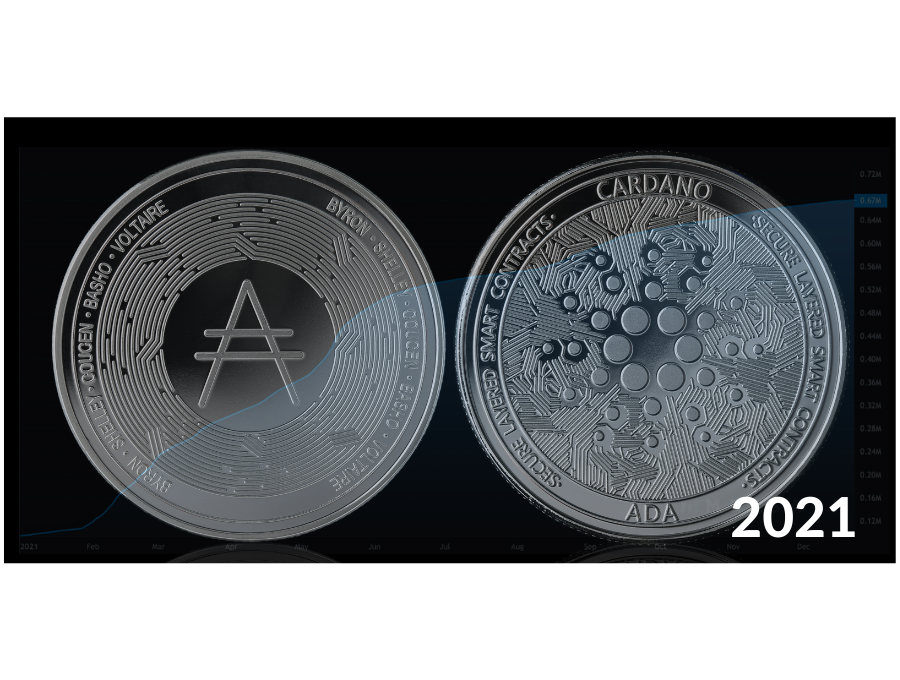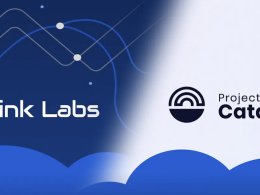It’s been quite the year for Cardano.
The accomplishments made across the blockchain over the past twelve months have proven thay the growth and development have not slowed down. However, the price speculation from a small subset of individuals tends to drown out and distract the attention away from some noteworthy achievements. If we follow the metrics and data, the on-chain analytics provide a different outlook for Cardano and why 2022 will be another interesting time in the evolution of this blockchain.
Social Metrics
Anecdotally, speak to anyone who follows the crypto industry closely and they’ll say there are few projects that have a larger following than Cardano. Taking a look at the social metrics of the past year, the Cardano Community has seen exponential growth and doesn’t look to be slowing down as we head into 2022.
At the beginning of the year, the subreddit r/Cardano had roughly 95k subscribers. Taking a look at the graph below, over the course of a year that number has increased by 625% and eclipsed 675k redditors by the time of publication. Comparing the numbers to Ethereum, r/Ethereum started the year with about 525k redditors and at the time of publication was over 1.2M, an increase of 228% over the past year.

The Cardano community is relatively large. Twitter has become the stomping ground for many crypto enthusiasts and announcing developments for projects across the industry. When taking a look on Twitter, it becomes apparent that many prominent Cardano focused accounts have sizeable follower counts. For example, the Cardano Foundation has 763k followers and Input Output also pulling a fairly modest 235k Twitter followers in comparison.
If the preferred medium is Facebook, there is also a rapidly growing official Cardano group which already hosts over 214k members. The developments and updates are usually discussed at great lengths on this platform. It gives the Cardano community members the chance to engage and interact with team members of specific projects or spokesmen of pillars within Cardano such as IOG, Emurgo, and the Cardano Foundation.
Upgrades & Developments
Cardano saw four major upgrades dating back to December of 2020: Allegra, Mary, Alonzo, and network parameter adjustments.
The first being the Allegra Hard Fork Combinator (HFC) event. This upgrade to the network introduced token locking and the ability to include metadata in transactions. Token locking is a way of recording how a specific token is being used for a certain purpose. Explained in a bit more depth in a blog post by IOHK:
Locking, in this case, means ‘reserving’ a certain number of tokens for a specified period of time so they cannot be disposed of to gain a benefit (such as voting, or running a smart contract).
The Second upgrade came by way of the Mary HFC in February. This event introduced the ability to create user-defined tokens changing Cardano into a multi-asset blockchain. Some of the first tokens we would see soon after this HFC event would be Spacebudz, Spacecoins, CardanoBits, and an explosion of other Cardano Non-Fungible Tokens (NFTs) to the ecosystem.
Next came the coveted Alonzo HFC in September. Cardano developers and enthusiasts had been awaiting this upgrade for quite some time. Alonzo brought “core Plutus smart contract capability to Cardano” and a more deterministic method of transaction processing. With Cardano’s unique Extended Unspent Transaction Output (eUTXO), smart contracts can provide the ability to guarantee the cost of transaction execution and how the transaction will behave before its submitted to the ledger.
Lastly, the blockchain saw an adjustment to the network parameters: block size increase and increasing Plutus script memory units per transaction. These adjustments came months after the implementation of Alonzo and smart contracts. The blockchain began to see a sizeable load as Cardano NFTs became increasingly popular and even bogging down the network at times. IOG chose to increase the block size by 12.5%, moving the block size from 64KB to 72KB. The next adjustment, the Plutus script memory units per transaction was also increased by 12.5%. The effects of this parameter change were highlighted in an IOG post:
An increase in Plutus memory limits means that they (developers) can develop more sophisticated Plutus scripts, or that existing scripts will be able to process more data items, increase concurrency, or otherwise expand their capabilities.
Wallet Distribution & Addresses
A critical aspect of discussing decentralization is taking a look at the distribution of the token native to a blockchain. As Ada is the native asset of Cardano, it’s important to see the wallet distribution within the ecosystem. It’s worth noting that one wallet does not equal one individual and many people often have an abundance of wallets but it does give some insights on the distribution and decentralization of a layer one smart contract platform.
Cardano reached two milestones that were widely recognized by the community and the accross industry. The first being 2 million wallets were generated across the blockchain. That’s a pretty massive number in comparison to other chains. The other wallet milestone was that 1 million wallets were delegating and staking Ada to support the network. The latter accomplishment speaks to the notion of these wallets and their active participation within the protocol.
Taking a deeper look into the data, the graphic below from Cardano Blockchain Insights gives a glimpse into the breakdown of address distribution. As of epoch 309, almost 79% of delegated wallets hold between 1-10,000 Ada or roughly 780k delegated wallets holding no more than 10k Ada. Looking at the other side of the spectrum, roughly 2,688 wallets or approximately a quarter of percent of all delegated wallets hold at least 1M Ada.

New Addresses & Active Addresses
Continuing to look at addresses, some more interesting wallet metrics come by way of IntotheBlock. They’ve managed to track the daily new addresses generated as well as the daily active addresses. IntotheBlock identifies an active address as making at least one transaction on a given day.
IntotheBlock analytics shows, in January, the newly generated Cardano addresses per day ranged between 15k-30k. Staying in January, the graph also depicts the daily active addresses ranged between 25k-50k. We can visually see an increase in both of these metrics over the course of the calendar year. Both the number of newly generated addresses and active daily addresses, peaked in November with over 304k and 485k respectively. Since then, those numbers have come down and averaged in December approximately 150k active daily addresses and over 75k new addresses, roughly 300 percent increase for both metrics since the beginning of the year.

Transactions & Block Size
Transactions have always been a benchmark within the industry to illustrate the throughput, capacity, and prospective capabilities of a particular chain. This metric can also be somewhat misleading, as all transactions are not created equally and some on-chain transactions carry more weight in some ecosystems more so than others.
On the 1st of January, the daily transaction count on Cardano was 9,004 transactions. The average daily transaction count in January was roughly 13.5k transactions per day. Fast forward to December, as of publication, the average transaction count for December is approximately 96k transaction per day. That’s an increase of 711% over the course of 2021. The peak for the year came on the 22nd of November when over 495k transactions were record in one day.

Average Daily Block Size
The next metric pulled from Messari’s analysis was the average daily block. The average daily block size remained fairly flat throughout the first half of the year. It wasn’t until the implementation of the Alonzo Hard Fork Combinator (HFC) event, which introduced Plutus Smart Contract functionality and the block size began to see a sizable increase. The Alonzo HFC occurred on the 12th of September.
The Messari graphic shows on the 1st of January, the average daily block size barely eclipsed 1.2MB. This trend continued with a few spikes around the Mary HFC in February, and another spike towards the end of May. However, the lead up to Smart Contract implementation was where the average block size began to increase drastically. At the time of publication, the average daily block size is approximately 34MB. The network saw its highest average block size on the 22nd of November at 53MB per block.

Native Assets & dApps
After the Mary HFC, the number of native assets or tokens on the Cardano Blockchain never slowed down. Another milestone on-chain was reached when over 2.5M Cardano native assets were minted since the beginning of March and a record 69,960 assets minted on the 5th of December.
dApps
The ecosystem is no longer recognizable to those who have been tracking Cardano for several years. It’s impossible to keep up with the multitude of applications, DeFi protocols, and wallets coming online everyday. It’s an exciting chapter that awaits community members as it’s been four years in the making and it seems that the ecosystem is on the cusp of delivering some dApps and protocols that will fuel innovation for years to decades. We’ll leave you with a rough screenshot of the current landscape of dApps being built (some are live) from the Cardano Cube interactive map. Enjoy and let’s see what 2022 brings for the Cardano Community.











